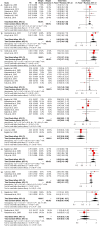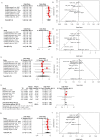Risk factors of postoperative delirium after cardiac surgery: a meta-analysis
- PMID: 33902644
- PMCID: PMC8072735
- DOI: 10.1186/s13019-021-01496-w
Risk factors of postoperative delirium after cardiac surgery: a meta-analysis
Abstract
Background: Postoperative delirium is a frequent event after cardiac surgery. This meta-analysis aimed to identify relevant risk factors.
Method: In this meta-analysis, all original researches regarding patients undergoing mixed types of cardiac surgery (excluding transcatheter procedures) and postoperative delirium were evaluated for inclusion. On July 28th 2020, we searched PubMed, Embase, Web of Science and Scopus. Data about name of first author, year of publication, inclusion and exclusion criteria, research design, setting, method of delirium assessment, incidence of delirium, odds ratio (OR) and corresponding 95% confidence interval (CI) of risk factors, and other information relevant was collected. OR and 95% CI were used as metrics for summarized results. Random effects model was applied.
Results: Fourteen reports were included with a total sample size of 13,286. The incidence of delirium ranged from 4.1 to 54.9%. Eight risk factors were identified including aging, diabetes, preoperative depression, mild cognitive impairment, carotid artery stenosis, NYHA functional class III or IV, time of mechanical ventilation and length of intensive care unit stay.
Conclusion: In this study several risk factors associated with postoperative delirium after cardiac surgery were identified. Utilizing the information may allow us to identifying patients at high risk of developing postoperative delirium prior to delirium onset.
Keywords: Cardiac surgery; Meta-analysis; Postoperative delirium.
Conflict of interest statement
The authors declare that they have no competing interests.
Figures




References
Publication types
MeSH terms
Grants and funding
LinkOut - more resources
Full Text Sources
Medical

